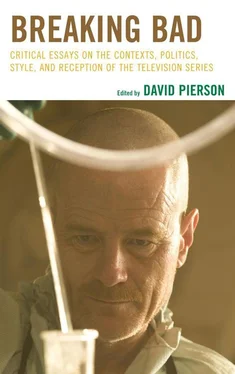Werner Heisenberg, the Nobel Prize-winning German theoretical physicist, is best known for his uncertainty principle, a symbolically appropriate theory that juxtaposes that which is known and is probable to happen in an experiment and the variables that are unknown. According to Heisenberg (1999), the probability function within an experiment “represents a tendency for events and our knowledge of events” (46). The principle’s relation to Breaking Bad ’s Walt is rather clear. Despite his best attempts to control his situations and foresee an outcome, unforeseen variables present themselves and spin a number of the narratives within the series into chaotic climaxes. Moreover, each occurring variable illustrates a merging of the feared Heisenberg and Walt, the meek chemistry teacher. This convergence of identity parallels Heisenberg’s note on dualism: “Generally, the dualism between two different descriptions of the same reality is no longer a difficulty since we know from the mathematical formulation of the theory that contradictions cannot arise” (50). In 1958, Heisenberg was referring to different perceptions and subsequent descriptions of an experiment observed by more than one scientist. However, his theory can also be applied to Walt, whose physical body and actions relate to the “same reality.” When Walt goes home at night, his actions as Heisenberg are not erased; they’re merely withheld from his family. The same can be said when he dons Heisenberg’s hat. His family is not erased; their existence is merely withheld from people like Jesse, Tuco, and Krazy-8. However, these realities are simultaneous and ever-present. The most significant aspect of Heisenberg’s theory is when he notes that “contradictions cannot arise” (50). Essentially, Walt and his Heisenberg do not exist separately. The emergence of Heisenberg erases the contradictions that were fostered within the Walt who became a chemistry teacher rather than a man at Gray Matter Technologies. Admittedly, this is a cynical look at Walt, and I’m aware that it suggests that pre-cancer Walt was less a docile, meek father, and more of a violent, cutthroat narcissist, but by the end of season four, I’m not sure that this assumption is as much of a stretch as it would have been during the first half of season one.
To re-contemporize our look at Walter through a Heisenbergian lens, we can once again visit Turkle (2011), who notes “When identity is multiple in this way, people feel ‘whole’ not because they are one but because the relationship among aspects of self are fluid and undefensive. We feel ‘ourselves’ if we can move easily among our many aspects of self” (194). Even though she is still referring to a virtual environment, Walt’s comfort in the emergence of Heisenberg and the ease with which he fluctuates can be seen in Turkle’s assessment of fluidity and the aspects of self.
Walt’s transition to Heisenberg allows him to create simultaneous living presents. As Deleuze (1994) asserts, a single living present includes “both the past and the future: the past in so far as the preceding instants are retained in the contraction; the future because its expectation is anticipated in the same contraction” (71). For Walt, the man dying of cancer, his path from chemist to chemistry teacher and through his diagnosis initially impels him to manufacture crystal meth to generate enough capital to leave a legacy to his family. At the same time, the creation of Heisenberg produces a second living present in which Walt-as-Heisenberg is allowed to erase his decision to leave behind his role as chemistry genius—and the correlated financial gain. The generation of a second present can be seen in Delueze’s (1994) claim that “Two successive presents may be contemporaneous with a third present, more extended by virtue of the number of instants it contracts. The duration of an organism’s present, or of its various presents, will vary according to the natural contractile range of its contemplative souls” (77). Deleuze refers to the emergence of multiple memories during any living present, but in the case of Walt, his memories—in the form of flashbacks—further drive him to intensify his relationship and actions to his second identity, which further connects to Deleuze’s idea that “a phenomenon such as need can be understood in terms of ‘lack,’ from the point of view of action and the active syntheses which it determines” (77). Simply put, Heisenberg’s arrival signifies that which Walt is deprived of: capital, power, and success. This leads us to a metempsychosis within the narrative, wherein “each is a passing present, one life may replay another at a different level, as if the philosopher and the pig, the criminal and the saint, played out the same past at different levels of a gigantic cone” (Deleuze 1994, 83). For Walt, a similar past exists for both himself and his Heisenberg, and it is this similar past that compels each to act and become one interloping and converging character.
This common past occupies a moment in time of what could have been (Heisenberg) and what is (Walt). Time signifies a fracture in the “I” that bifurcates pre-diagnosis Walt into post-diagnosis Walt and Heisenberg, something that allows Walt to atone for his formerly callow and pusillanimous demeanor, which is alluded to most notably in the conflict between Walt, Elliot, and Gretchen. The confidence that Walt exudes with Gretchen while talking about the elemental composition of the human body is palpable as is his passion when he leans in for a kiss prior to the end of the flashback. [9] This flashback occurs in the episode “…And the Bag’s in the River” (2/8/08).
However, Skyler and Walt’s presence at Elliot’s birthday party reeks of discomfort and anxiety, much like the way that Walter perfunctorily responds to Gretchen’s claim about his half of the money. For a better look at pre-diagnosis Walter, we can build from David Hume’s (2000) notion that personal identity is a fiction, with “nothing really belonging to these different perceptions, and uniting them together; but is merely a quality, which we attribute to them” (loc. 3825). If this is the case, then Walt’s identity as “Walter” is merely a pervasive construction of the perceptions that surround him, placing his self in what George Mead referred to as the “attitude of the other” (Gallagher 1998, 50). This attitude of the other is even present within the series’ title. The present continuous “breaking” suggests a process, one that is ongoing and—depending on how season five ends—infinite. Critical to the discussion of attitude is the adjective “bad.” The notation of bad both establishes a stereotype for the business Walt is entering and the stigma that surrounds Walt—‘good.’ I have no objection to Walt being largely seen as a ‘good’ father, ‘good’ husband, or all around ‘good’ guy, pre-diagnosis. As the series progresses, however, this label becomes wonky and misleading, suggesting that the façade that Walt wears is once again linked to social expectations, or the attitude of others. Regarding this attitude, we can turn again to Mead who further believes “since we are already a product of other relations, our own experience of time is already conditioned by others” (Gallagher 1998, 113). If this is the case, then we can also interpret Walt’s Heisenberg as a means to recoup his time spent as a social construction of those around him.
Ironically enough, Walt’s alter ego fashions a scenario similar to his previous existence: the violent, powerful, narcissistic Heisenberg is a product of the attitude of others. In “Negro y Azul” (4/19/09) a narcocorrido [10] A narcocorrido is a Mexican ballad centered on the exploits of drug traffickers in Mexico.
illustrates the constructed attitude of others toward “Heisenberg’s fame,” as the “gringo boss,” with the blue stuff that “no one could stop it if they wanted to.” This ballad seems to set Walt on the path that culminates in a confrontation with Skyler in “Cornered” (8/21/12) in which she asserts that he is not a criminal, but rather a man caught in an untenable position. Aghast and growling, Walt retorts, telling her that he is not the one in danger, rather he has become the danger. While this scene showcases Cranston and Gunn’s acting abilities, it also serves to illustrate Walt as an egotist. But, his ego is a product of those around who exhibit fear at the name of Heisenberg.
Читать дальше












